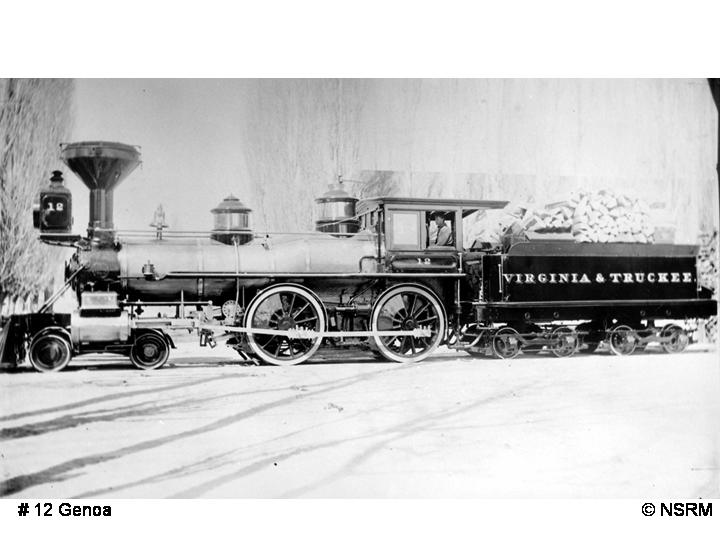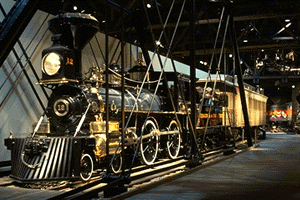
V&T Locomotive #12 "Genoa"


V&T Locomotive #12 "Genoa"
![]()

Virginia &
Truckee Railroad No. 12 Genoa is a classic example of the conventional
4-4-0 American-type steam locomotive, the standard engine of most railroads in
the United States for nearly three decades. By 1870 over half the locomotives in
the nation were of this type. The 4-4-0 wheel arrangement was designed for
maximum traction, power and speed. The light-weight and compact nature of the
engine made it very flexible for all types of track conditions and train
operations.
By 1873, the year the Genoa was completed, the 4-4-0 had reached a mature
design with calculated proportions, improved details, a graceful appearance, and
an elegance and effectiveness which remained unchanged for nearly a quarter of a
century.
The Virginia & Truckee Railroad Company was organized in Nevada on March 5, 1868
to connect the Comstock ore-producing mines with quartz-reduction mills located
along the Carson River, approximately three miles east of Carson City. The
twenty-one mile standard-gauge line between Carson City and Virginia City was
completed on January 29, 1870. A thirty-one mile extension south from Reno
through Franktown, Washoe City, and Steamboat Springs connected the Comstock
with the Central Pacific Railroad in August 1872.
The wood-burning Genoa was outshopped in January of 1873 by the Baldwin
Locomotive Works of Philadelphia. For nearly thirty years No. 12 hauled
passenger, mixed and occasionally freight trains for the Virginia & Truckee
Railroad between Carson City, Virginia City and Reno, Nevada.
Early Virginia & Truckee engineers liked to operate the Genoa, believing
her to be one of the fastest of the railroad's original twenty-four steam
locomotives. For this reason, it saw considerable duty on special and excursion
trains. When requisitioned for freight service, the Genoa easily handled up to
seven of the Virginia & Truckee's fully loaded wooden freight cars. Locomotives
were once colorfully painted and trimmed. Shop wipers worked at 25 cents per
hour for ten-hour days to polish brass fittings and keep V&T locomotives
sparkling. The Virginia & Truckee took great pride in its maintenance
procedures, and the passenger locomotives in particular received special
attention. By 1902 the paint scheme of locomotives on the Virginia & Truckee and
most other railroads, had been simplified considerably with black replacing the
bright colors of earlier years. Even then, the Genoa retained most of her
brass trim and V&T crews continued to provide careful maintenance and cleaning.
By 1908 passenger service had declined to a point where the locomotive was no
longer needed for revenue service. On December 31, 1908 No. 12 was retired to a
stall in the Carson City enginehouse. As she had run only 3,246 miles since her
last overhaul, she was stored in prime operating condition.
The locomotive remained in storage until 1939 when, after sale to the Eastern
Railroads Presidents' Conference, it left for the East Coast to begin a two-year
career in excursion and display service. The Genoa was modified to
represent Central Pacific's No. 119 Jupiter for performances in the
Golden Spike scene at the pageant "Railroads on Parade" during the New York
World's Fair (1939-1940). It also operated at the Chicago Railroad Fair in 1948.
After the Chicago fair, ownership was transferred to the Pacific Coast Chapter
of the Railway & Locomotive Historical Society which in turn presented the
locomotive to the State of California in 1969.
In 1969 the Genoa again appeared as the Jupiter in the one
hundredth anniversary celebration of the completion of the transcontinental
railroad held at Golden Spike National Historic Site, Promontory, Utah.
After its last wood-fired operation under steam in May 1979, the Genoa
was restored to its 1902 appearance. It is displayed in the Great Hall of the
Museum of Railroad History, pulling Virginia & Truckee combination car No. 16
across an 1884 Phoenix Bridge Company cast-iron railroad bridge.

Displayed at The
California State
Railroad Museum
![]()
Return to Previous Page
Modified
Monday December 08, 2008